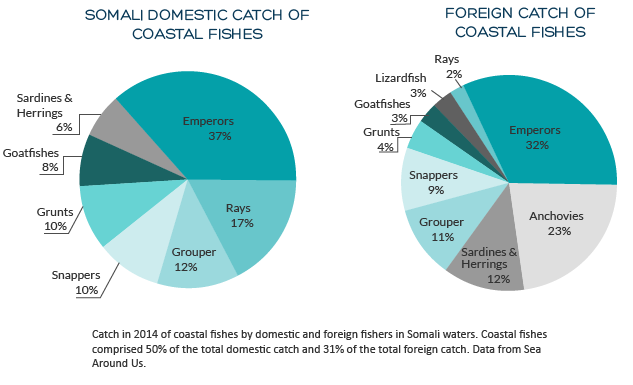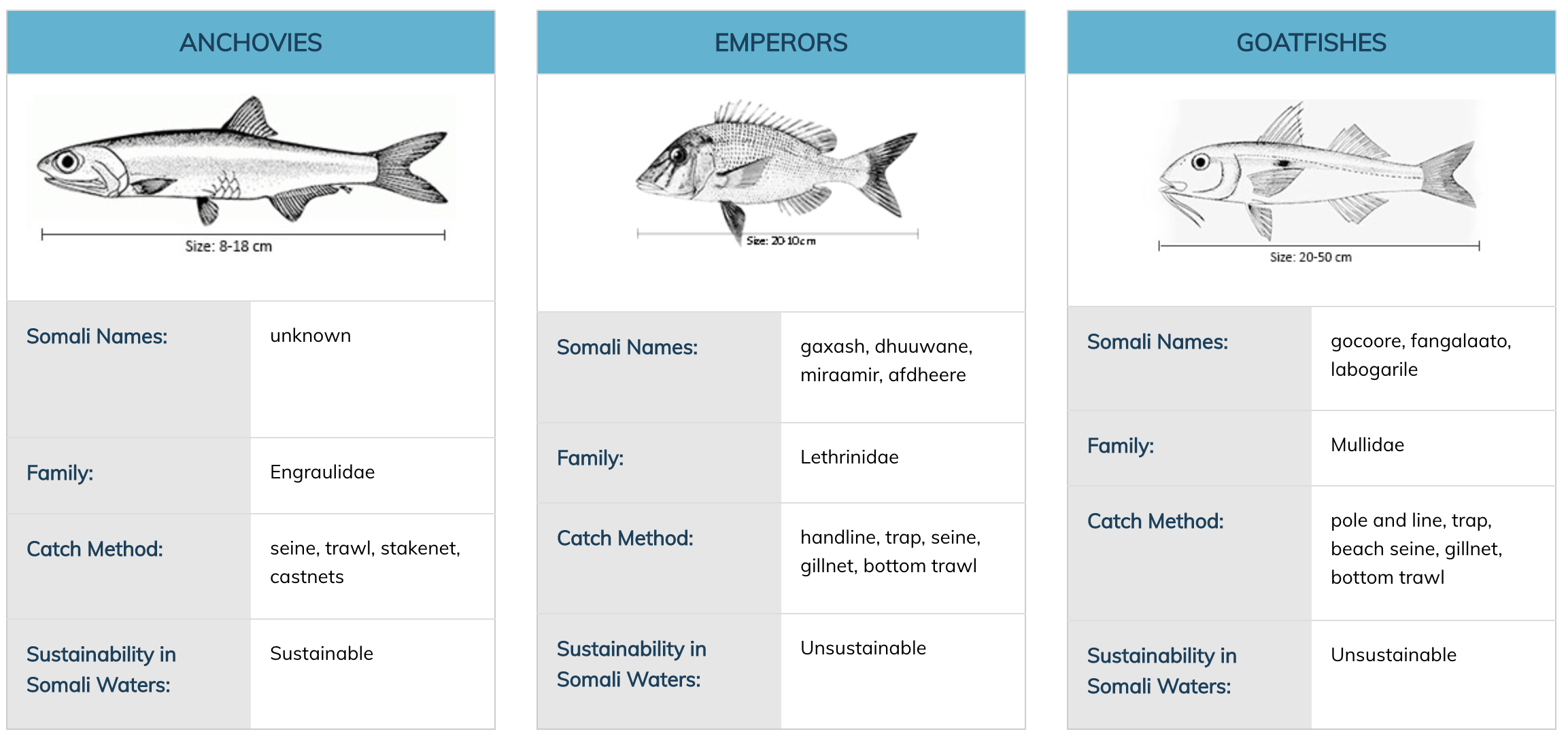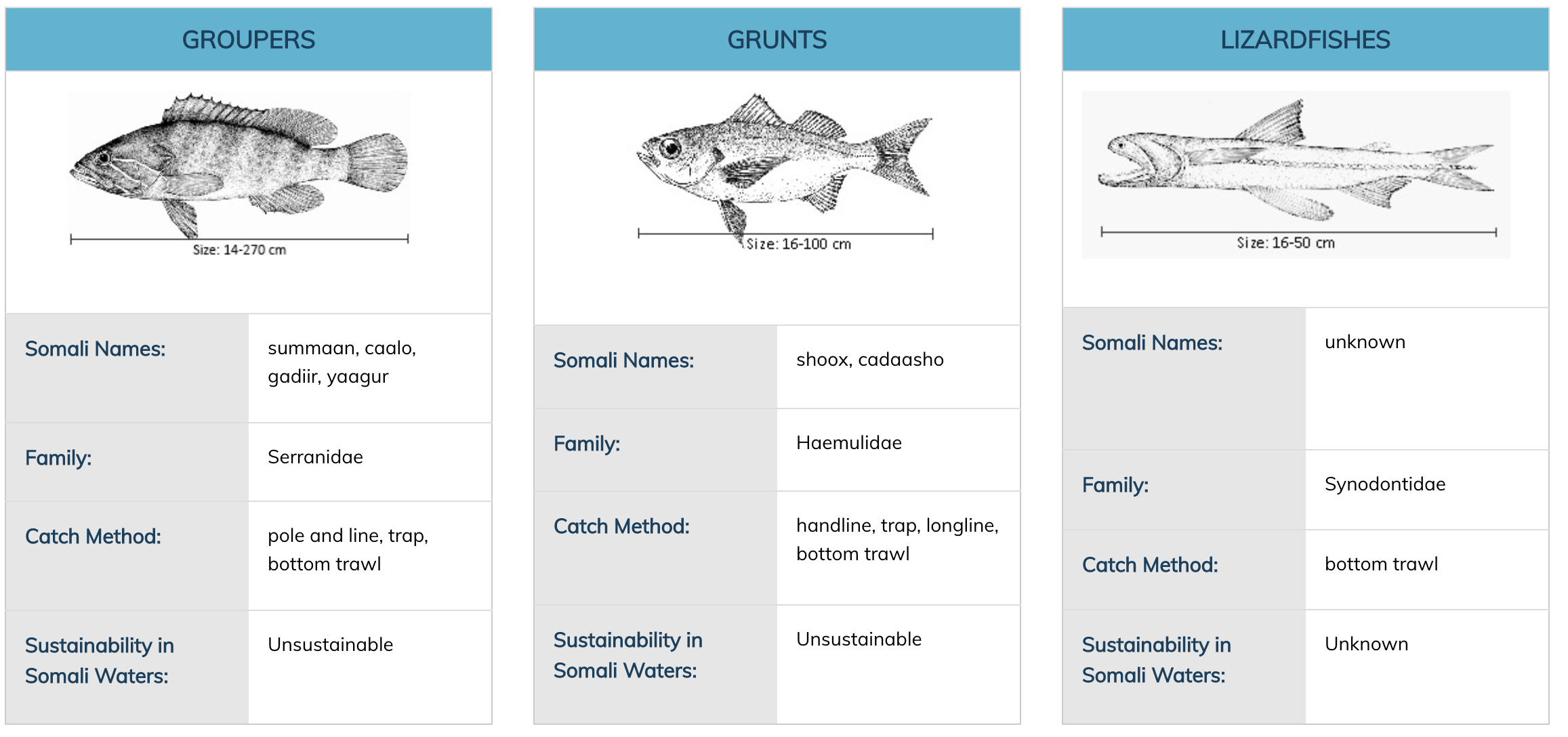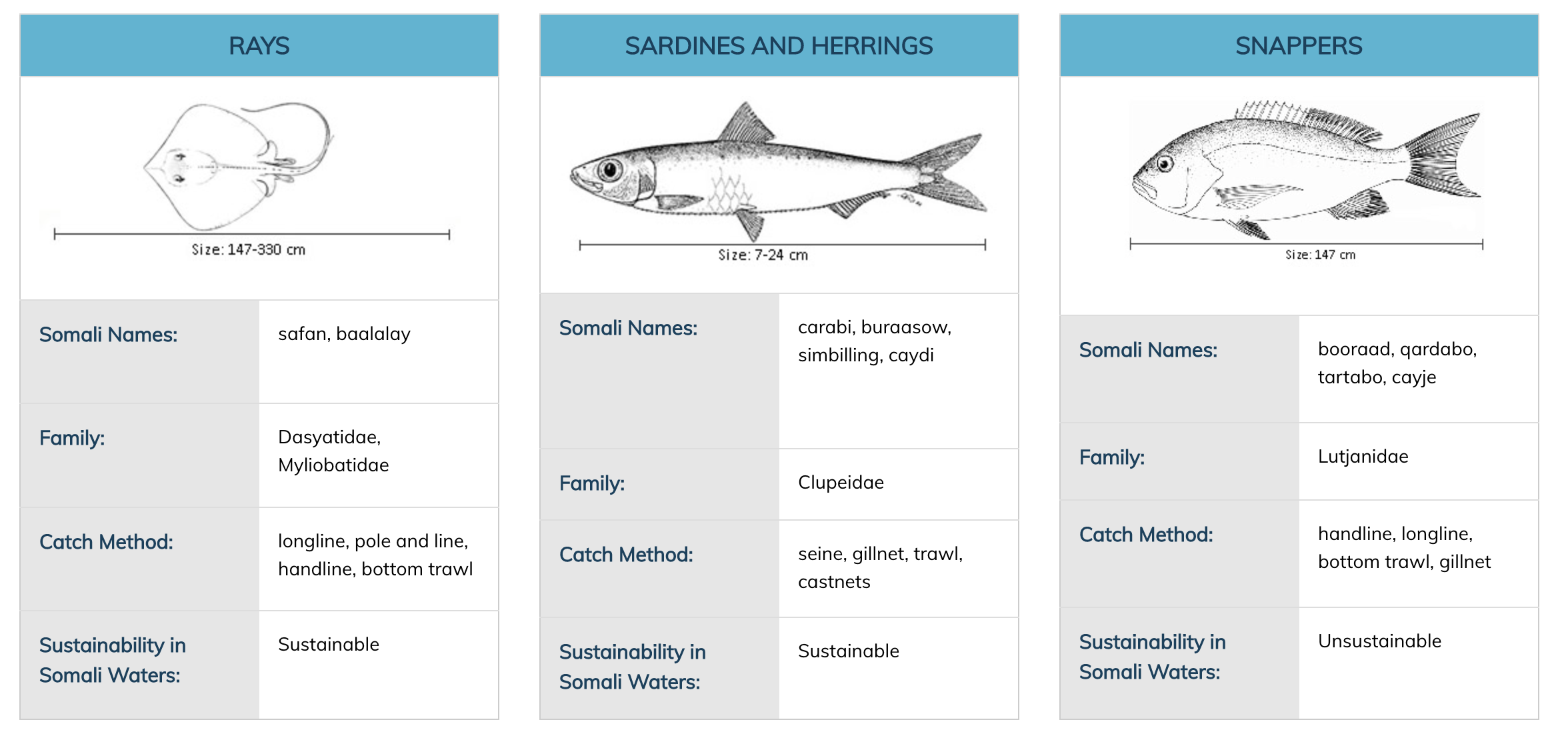
Coastal fishes are an extremely important part of Somali domestic catch. They support local economies and are sources of food for coastal communities. Ecologically, coastal fishes occupy the bottom and middle of the food chain. Fishes like the small, silvery anchovies, sardines, and herrings are important food fishes for other larger fishes. In the middle of the food chain, emperors, goatfishes, groupers, grunts, lizardfishes, and snappers, are both predators and prey. They eat smaller fish or invertebrates (clams and snails) and are in turn eaten by larger animals such as sharks.
Somali artisanal fishers and foreign fishers compete for these fishes, creating the need for sustainable management measures to protect the resource and thus Somali fishers’ livelihoods. While some species are currently fished unsustainably according to the Secure Fisheries' report, Securing Somali Fisheries, opportunities exist to expand artisanal fisheries and increase efficiency throughout the supply chain to take advantage of the export market for these fishes.
Small Schooling Fishes
Anchovies, sardines, and herrings are some of the most abundant and commercially important fishes around the world. They are generally small, silvery, round or narrow-bodied, and schooling fishes that are important prey for many larger fishes, marine mammals, and sea birds. They can be found in very large numbers in one location, so they are often caught by commercial purse seine vessels that use a large net to surround and catch an entire school to be processed into fishmeal for fertilizer or feed for livestock or farmed fish. Anchovies, sardines, and herrings are biologically and evolutionarily different groups, but their ecological roles, behaviors, catch methods, and commercial uses are similar.
These small, open-ocean fishes offer a potential sustainable fishery development opportunity that could increase food and economic security in Somali coastal communities. Anchovies, sardines, and herrings are traditional foods in many places including Europe and parts of Africa. They are excellent sources of protein, fats, and nutrients. Additionally, their small size means they can be easily dried or salted, making anchovies a good food source in places with limited refrigeration capacity. As fishing, infrastructure, and processing capacities expand, it may be feasible for Somalis to produce fishmeal for use in agriculture and livestock, expanding opportunities for growth of these sectors. However, a thorough assessment of the sustainability of the fish stocks would be needed before this scale of expansion to avoid overfishing. These fisheries are also susceptible to changes in their food sources, water quality, and other environmental effects from climate change. Their boom and bust population dynamics need careful management plans to prevent collapse, which would negate investments into the infrastructure around the fishery.
Mid to Large Reef Fishes
Mid- to large-sized reef fishes of commercial importance in Somali waters include emperors, goatfishes, groupers, grunts, lizardfishes, and snappers. These fishes generally live alone or in small groups and feed on smaller fish and bottom-dwelling invertebrates such as crabs, worms, and clams. These groups are desirable food fishes for humans, making them important on the local market and a potential export product.
Association with sensitive shallow habitats including coral reefs, seagrass beds, and mangroves can increase the risks these fishes face. Pollution from coastal development near large ports harms reefs and seagrasses and destructive fishing practices like trawling can destroy these fishes’ preferred habitats. Additionally, these fish groups are targeted both by Somali fishers and foreign trawlers and gillnetters (vessels that drag large nets across the seafloor and passive nets set to entangle fish, respectively). As a result, many of their populations in Somali waters are currently fished at unsustainable levels. Without regulation of foreign fishing vessels and protections for domestic fishers and sensitive coastal habitats, the populations of these species could collapse, eliminating a major source of food and economic security for Somali coastal communities.
Rays
Rays are flat fishes that are related to sharks. They have cartilaginous skeletons and their flat shape, with eyes on top of their bodies, allows them to camouflage and bury into the sea floor where they wait for prey and avoid predators. Rays feed on shellfish, crustaceans (crabs, shrimp, etc.), and small fishes. They often are caught as bycatch in net fisheries and are a common food item in Asia. The populations of many ray species in the Western Indian Ocean are at risk. Of the 292 species present in the Western Indian Ocean region, more than half are listed as vulnerable, endangered, critically endangered, or without enough data to make an assessment. Many ray species are slow to reproduce. If their populations were fished to low levels, they would be slow or unable to recover.



Go To Project Badweyn Overview and Interactive Map
Data Attribution and License Information
Data analysis and visualization by Paige Roberts. Data obtained from Pauly D and Zeller D (Editors) (2015) Sea Around Us Concepts, Design and Data (www.seaaroundus.org), downloaded 8/1/2018.
Data obtained from Kaschner, K., K. Kesner-Reyes, C. Garilao, J. Rius-Barile, T. Rees, and R. Froese. 2016. AquaMaps: Predicted range maps for aquatic species. World wide web electronic publication, www.aquamaps.org, Version 08/2016.
This work is licensed under a Creative Commons Attribution-Noncommercial 3.0 Unported License (CC-BY-NC). For more information and for data downloads see www.aquamaps.org.
Bibliography
FAO Fisheries and Aquaculture Department. “Fact Sheets.” FAO FishFinder. Accessed August 28, 2017. http://www.fao.org/fishery/species/search/en.
Glaser, Sarah M., Paige M. Roberts, Robert H. Mazurek, Kaija J. Hurlburt, Liza Kana-Hartnett. Securing Somali Fisheries. Denver: One Earth Future, 2015. Available here.
Helfman, Gene S., Bruce B. Collette, and Douglas E. Facey. The Diversity of Fishes. Malden: Blackwell Science, Inc., 2004.
IUCN. 2021. The IUCN Red List of Threatened Species. Version 2021-3. https://www.iucnredlist.org. Accessed on May 19, 2022.
Sea Around Us. “Catches by Taxon in the waters of Somalia.” Tools & Data. Accessed August 16, 2017. http://www.seaaroundus.org/data/#/eez/706?chart=catch-chart&dimension=taxon&measure=tonnage&limit=10.
Windsor, M.L. “Fish Meal.” FAO Corporate Document Repository. Accessed August 28, 2017. http://www.fao.org/wairdocs/tan/x5926e/x5926e01.htm